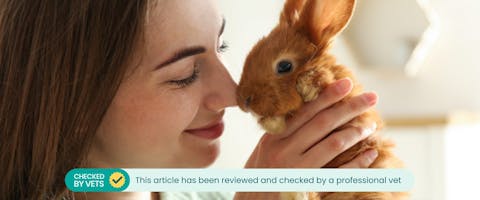Updated 17/02/2024
Pet sitting comes in all different shapes and sizes, and today we’re shining a light on our pint-sized pals. From itty-bitty bunnies with personalities larger than life to pocket-sized hamsters that leave tiny paw prints on our hearts, pet sitting for small animals is anything but a small-time gig. So whether you’re going to be rabbit sitting, pet sitting guinea pigs, or taking care of a household of hamsters, let’s take a look at what you can expect from small pet care.
What do small pets eat?
Pet parents should provide you with guidance on what to feed their furry friends and when (including their favorite healthy treats!), but you’ll always need to make sure they have access to clean, fresh water. Hamsters, guinea pigs, and rabbits often drink from drip-feed water bottles that are attached to their cage, and it’s a good idea to test if they’re still working when you’re cleaning them out by pressing a finger on the water valve. Here is a general guide to what you can expect to feed your furry friend while pet sitting for small animals:
- Rabbits: Clean, safe leafy greens such as broccoli, kale, cabbage, and parsley, plus good-quality pellets and plenty of good quality fresh hay.
- Guinea pigs: Good-quality hay, safe leafy greens such as cabbage, broccoli, kale, carrots, bell peppers, or green beans, fresh grass (not from the lawnmower), and pellets.
- Chinchillas: Good-quality hay and grass-based chinchilla pellets. You should avoid feeding any nuts or seeds.
- Hamsters and mice: Mice/hamster pellets, seeds, small quantities of greens, and certain safe fruits and vegetables such as carrots, broccoli, and cabbage.
Trending posts
Purr-use some of the top blogs our members have been loving this month- Top male dog names for your new furry friendGot a new furry family member in your pack? Check…

- Top female dog names for your new fluffy palWelcoming a new pooch into your family? Explore…

- 120+ gray cat names your silver feline will loveRecently welcomed a fluffy gray bundle of joy into…

- What are normal pet sitting rates?Discover the average pet sitting rates for animals…

- Unique dog names to stand out from the packDare to be different with our list of the best…

What supplies do small pets need?
Your fluffy friend’s living space should have been established in terms of safety and comfort by the pet parents, but it will be your responsibility to keep the area safe and secure during your house sit. Most small pets live in some sort of cage, which will often be filled with a variety of bedding, food bowls, and toys or exercise equipment. Here is a list of some of the supplies you can expect to see:
- Cage, tank, or similar habitat
- Bedding material such as woodchips, shavings, shredded newspaper, or hay
- Toys
- Exercise equipment
- Feeding bowls
- At least one drip-feed water bottle (or water bowl)
- Treats
- Cozy nooks to hide in
How to care for small pets
Pet parents should leave you with a list of small pet care instructions specific to their little fur baby, but there are a few key things you’ll need to know:
- The cage, tank, or “living quarters” will need to be cleaned regularly, at least once a week in most cases.
- You may also be required to groom and clean the pet itself.
- In order to maintain a level of normalcy, try following your furry friend’s daily routine and engaging them in stimulating activities that will avoid them feeling stressed or anxious.
- While small pets often spend lots of time in their cage, many pet parents take them out for daily handling and playtime. Whether your chinchilla companion likes to run around the living room to stretch his legs or your hamster homie typically enjoys some time going around in his plastic ball after dinner, it’s important to ensure you’re meeting your furry friend’s playtime and exercise needs.
Preparing for emergencies
Whether you’re small dog sitting or taking care of a gaggle of guinea pigs, always prepare for the unexpected by making sure you’re made aware of any medical conditions your petite pal may have and you’ve read up on any signs they’re feeling under the weather. Pet parents should provide you with their contact details and those of the local vet in case of an emergency, but remember that you also have access to a 24/7 vet advice line on Standard and Premium Sitter plans.
Whether you’re caring for rabbits, hamsters, and guinea pigs or lizards, frogs, and fish, your number one priority will be ensuring your furry, feathered, or scaly friends receive the love and care they deserve. And if you want more information about caring for little fluffy ones, check out our guide to pet sitting for ferrets and rodents.
Meet our veterinary expert, Holly
This article has been checked by veterinarian Holly Anne Hills BVM BVS BVMedSci. After graduating from the University of Nottingham, Holly spent two years working as a farm animal vet. She then spent some time traveling and volunteering in India, working at neutering clinics and with injured street dogs. Holly now works in small animal practice, and balances this with writing, volunteering with the comms team at Vet Sustain, and she is also a marine mammal medic!
More interested in looking for rabbit sitters or a bunny sitter near me? Discover thousands of verified, 5* sitters today!

